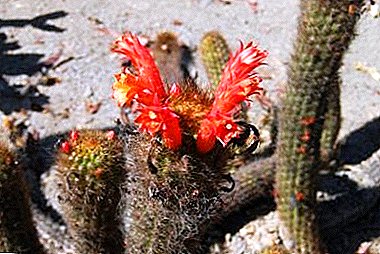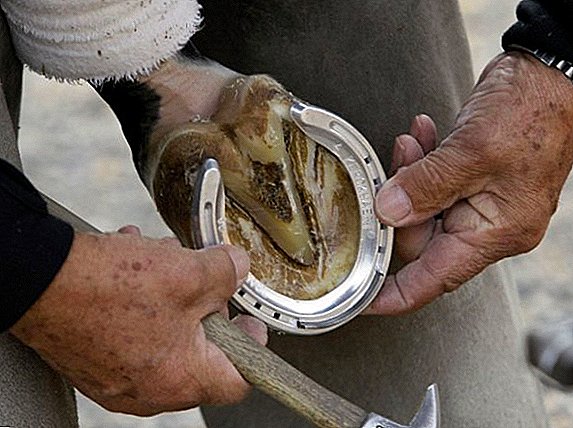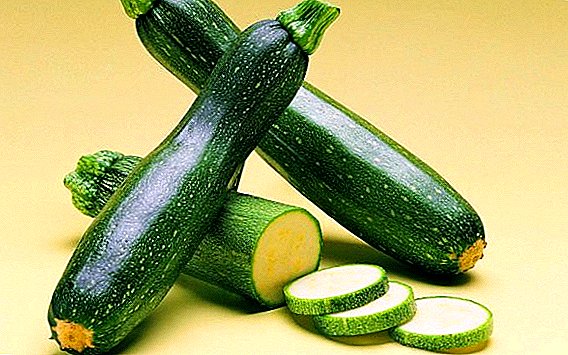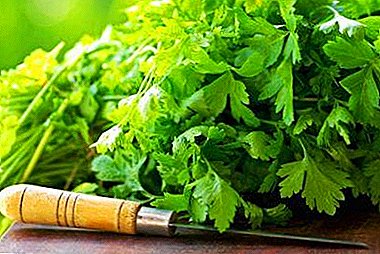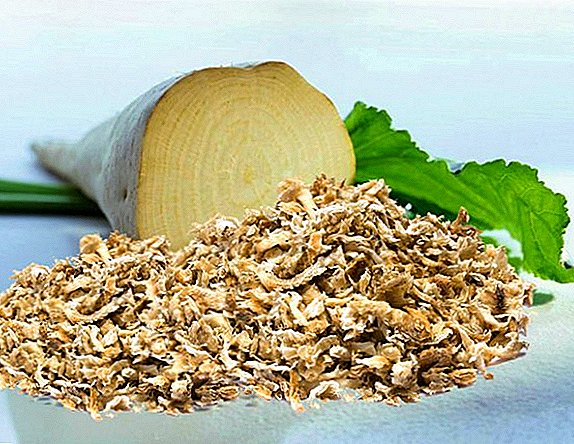 Beet pulp is a very popular product in the diet of cows. It can be fed in a different form, but the product in granules is the most common and convenient. Its use has a lot of advantages and its features. About how and in what dosages to use this raw material for cattle, how to store it - let's talk further.
Beet pulp is a very popular product in the diet of cows. It can be fed in a different form, but the product in granules is the most common and convenient. Its use has a lot of advantages and its features. About how and in what dosages to use this raw material for cattle, how to store it - let's talk further.
What is beet pulp
Pulp called any residue after the squeeze, in this case - it is dried sugar beet chips, after extracting sugar crystals from it. In fact, it is waste material from sugar factories, which can be sold to farmers and agricultural holdings as feed, making additional profit.
Did you know? Until the XVIII century, the amount of sugar in beets did not exceed 1-2%, however, with the participation of breeders for a couple of centuries, new varieties for sugar production, in which the amount of the substance reaches 20%, were bred!
The shavings can be used immediately after the extraction of sugar in its raw, moist form. But most often it is processed further, enriched with additional components.
Depending on the method of manufacturing (processing) and the additives introduced, there are several types of pulp:
- dried granules - the most popular form due to the long shelf life, nutritional value and ease of manufacture;
- sour canned pulp - processed by ensiling;
- molasses - obtained by adding molasses (molasses);
- amide - obtained by adding molasses and urea (urea, nitrogenous fertilizer);
- amido mineral - besides urea, molasses, phosphate, mineral components, mirabilite are added;
- bard - obtained by adding bards (waste in the form of ground after brewing or distillation).

Such processing allows you to keep the final product for a long time, increasing its taste, nutritional value and, consequently, benefits for the animal.
We advise you to read about how to properly fatten cattle.
Advantages and disadvantages of using as cattle feed
Beet pulp in the form of granules occupies a very important place in the diet of cattle, and for good reason.
The benefits of using it are significant:
- high nutritional value;
- high digestibility of useful substances;
- increase milk production, weight gain, slaughter rate, as well as the quality of the skins;
- sweet taste, thanks to which bag mash with pulp become more attractive for animals, which leads to better appetite and rapid weight gain;
- long shelf life;
- ease of transportation;
- lower feed costs.

However, when using the pulp in the diet, certain difficulties may arise, some of them are associated with a violation of daily dosages and errors in the application:
- the need to soak the granules, as in the dried form it is absolutely impossible to feed them to cattle;
- the need for weighing the dosage to determine the exact daily dose;
- deterioration of the quality and taste of milk and dairy products with non-compliance with the daily rate;
- digestive disorders (mainly in young animals, as well as non-compliance with the dosage).
Raw pulp is an excellent source of fiber and carbohydrates, stimulates the stomach and does not overload the digestive system. Molasses pulp (also in the form of granules) improves the taste of meat and milk, normalizes digestion, saturates the body with glucose. Other types of pulp are used less frequently.
Did you know? The digestive system of the cow is unique: the length of the intestine is on average 50 m, and the volume of the stomach can reach 250 liters, with 80% of the volume falling on the largest section, the scar.
Features of dry granulated beet pulp
Thus, the benefits of the introduction of beet pulp in the diet is undeniable. But in order to certainly understand why this product is so useful, consider the features of its production and chemical composition. 
How is it made?
Beet pulp is actually dried “de-sugared” beet chips, pressed into pellets.
The product is made in several stages:
- The root crop is washed, cleaned from the peel and tops and crushed to chips not thicker than 2 mm.
- A large amount of water is passed through the chips, in which the sugar from the vegetable dissolves. Next, the concentrated liquid flows.
- Wet chips are dried with steam at a temperature of about +150 ° C, as a result, the amount of moisture in the product varies from 6 to 14%.
- Dried chips are ground into flour, enriched with protein, chopped, lactic acid bacteria.
- Flour is formed into granules on a special apparatus, which pass the final drying.
Find out what is concentrated feed.
Beet chips can be used immediately after sugar extraction in a wet form (water content is about 90%), but in this case it will have a very short shelf life - about 48 hours. In general, wet shavings can be used by farms located within a radius of 25 km from the sugar factory.
Transportation of feed over longer distances is not profitable at the financial and time costs. That is why it is more rational, advantageous and practical to use exactly dry granulated feed. 
Chemical composition
In animal husbandry, this product is a valuable source of crude protein, easily digestible fiber, carbohydrates, minerals and vitamin substances. It is introduced into the diet in order to replace the roots, for the manufacture of animal feed.
It will be useful for you to read about what the weight of cattle depends on, how to properly feed the cows on pasture, how to wean the cow butt, how to measure the body temperature of the cows, and what to do if the cow is poisoned.
Immediately after sugar extraction, the pulp is 90% water and therefore its nutritional value is rather low, but after drying and granulating, the amount of dry matter in it rises to 85-94%.
The main components in the composition:
- pectic substances - 50%;
- cellulose - 45-47%;
- protein - 2%;
- starch and sugar - 0.6-0.7%;
- micro- and macronutrients (calcium, phosphorus) - 1%;
- vitamins (B1, B2, B5, B6, B, C);
- amino acids (lysine);
- cellulose;
- ash;
- fats.

Storage rules
To ensure that all the nutrients remain in the granulated pulp, and the animal benefits from it, the raw materials must be properly stored:
- the room for the storage of raw materials must be repaired, with hermetic windows, doors, roof, concreted floor in order to prevent moisture ingress;
- due to the fire hazard of dry granules of the pulp near the place of storage there should not be any (!) flammable substances and materials;
- temperature condition: 0 ... +25 ° С, when temperature deviates, product may freeze or be sour, at very high temperatures it is possible that a fire may occur;
- bags, big bags (soft containers) are best for storage;
- you need to strictly monitor the humidity in the room, the permissible rate - up to 60%;
- the moisture content of the granules themselves should not exceed 15%.
Important! When the moisture content is at least 5-6%, xerophilic mold begins to develop, then the spores of the usual mold and pathogens multiply, which causes damage to the product (self-heating, molding, souring). It is strictly forbidden to feed such animals with animals!
How to feed cows with beet pulp
This product is nutritious, well-digestible and palatable to animals, but must be given taking into account daily dosages in order not to disturb digestion. Before feeding, the granules should be soaked in warm (not hot) water at a ratio of 1: 3 (3 parts of liquid).  In no case it is impossible to give raw materials in any case, as swelling in the stomach will cause the feed to upset digestion, trauma to the stomach walls, constipation and other problems with the gastrointestinal tract.
In no case it is impossible to give raw materials in any case, as swelling in the stomach will cause the feed to upset digestion, trauma to the stomach walls, constipation and other problems with the gastrointestinal tract.
Daily rates of fresh raw materials for various groups of cattle:
- dairy adult cows - 30-40 kg per individual;
- young cattle - 30 kg per individual;
- adults of the meat direction - 50-70 kg.
Read more about how to feed a dairy cow, as well as familiarize yourself with the steps of feeding a calf.
When feeding dry pulp in granules, the norms should be reduced approximately 10 times:
- dairy adult cows - 3-4 kg;
- calves - 3 kg;
- adult meat individuals - 5-6 kg.
If there are potatoes in the weeds ration, the amount of pulp should not exceed 1/5 of the total daily amount of feed, but if there are no potatoes in the diet, it is permissible to increase the amount of pulp to 25% of the total daily feed. It is also worth remembering that when feeding this product in the diet must be present coarse feed (hay, straw).  Exceeding the daily recommended dosages of the product is fraught with the following consequences:
Exceeding the daily recommended dosages of the product is fraught with the following consequences:
- rapid souring of milk, changing its taste, chemical composition, density and coagulability;
- as a result, the cheeses from such raw materials ripen in the wrong time, the oil has a firm consistency and a pronounced white tint;
- A digestive disorder occurs in calves that feed on milk from cows with excess pulp in the diet.
Important! Soaked pulp should be used immediately or within a few hours, as the product sours quickly, especially in the warm season.
What farm animals can be given
Beet pulp can be called a universal product suitable for feeding many agricultural animals, except for cows:
- horses;
- pigs;
- goats;
- sheeps.

The daily dosage for the listed animals is selected taking into account their weight. Thus, we can conclude that beet pulp in the form of granules is a versatile, nutritious, relatively inexpensive and very popular type of feed in animal husbandry, which can significantly increase production rates, as well as the quality of milk and meat.


